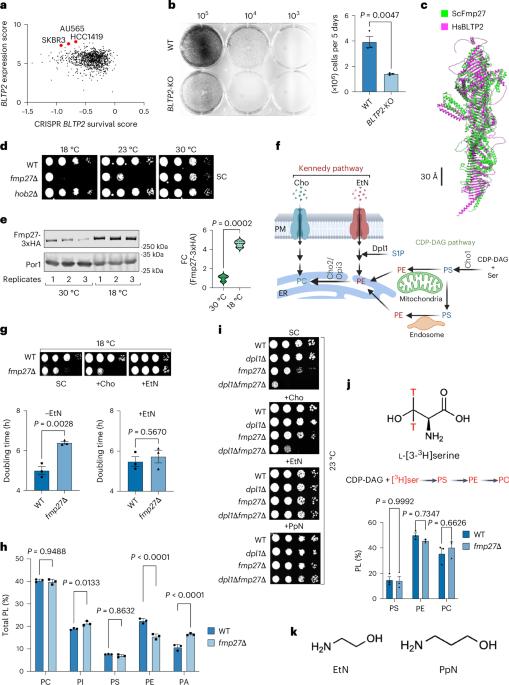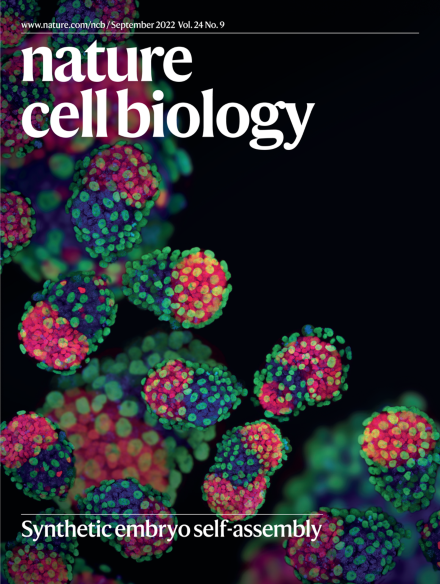vps13样蛋白BLTP2调节磷脂酰乙醇胺水平,维持质膜流动性和乳腺癌侵袭性
IF 19.1
1区 生物学
Q1 CELL BIOLOGY
引用次数: 0
摘要
脂质转运蛋白(LTPs)促进细胞间非囊泡性脂质交换,在脂质稳态中起关键作用。最近发现的桥状LTPs (BLTPs)家族被认为在细胞器之间形成脂质运输管道。其中的BLTP2是跨物种保守的,但其功能尚不清楚。在这里,我们发现BLTP2通过增加PM中磷脂酰乙醇胺(PE)的水平来调节质膜(PM)的流动性。BLTP2定位于内质网(ER) -PM接触部位,并在体内运输PE,表明它驱动PE从ER到PM的运动。我们发现BLTP2与另一种调节细胞内PE分布和PM流动性的途径并行工作。BLTP2表达与乳腺癌侵袭性相关。我们发现BLTP2促进三阴性乳腺癌细胞系的生长,并在体内转移模型中维持其侵袭性,这表明BLTP2维持PM流动性可能对人类肿瘤发生至关重要。本文章由计算机程序翻译,如有差异,请以英文原文为准。

The Vps13-like protein BLTP2 regulates phosphatidylethanolamine levels to maintain plasma membrane fluidity and breast cancer aggressiveness
Lipid transport proteins (LTPs) facilitate non-vesicular lipid exchange between cellular compartments and have critical roles in lipid homeostasis. A recently identified family of bridge-like LTPs (BLTPs) is thought to form lipid-transporting conduits between organelles. One of these, BLTP2, is conserved across species but its function is not known. Here we show that BLTP2 regulates plasma membrane (PM) fluidity by increasing phosphatidylethanolamine (PE) levels in the PM. BLTP2 localizes to endoplasmic reticulum (ER)–PM contact sites, and transports PE in vivo, suggesting it drives PE movement from ER to PM. We find that BLTP2 works in parallel with another pathway that regulates intracellular PE distribution and PM fluidity. BLTP2 expression correlates with breast cancer aggressiveness. We found that BLTP2 facilitates growth of a triple negative breast cancer cell line and sustains its aggressiveness in an in vivo model of metastasis, suggesting maintenance of PM fluidity by BLTP2 may be critical for tumorigenesis in humans. Banerjee et al. report that the Vps13-like lipid transport protein BLTP2 regulates plasma membrane fluidity by maintaining phosphatidylethanolamine homeostasis. BLTP2 also facilitates breast cancer cell growth, suggesting a separate role in tumorigenesis.
求助全文
通过发布文献求助,成功后即可免费获取论文全文。
去求助
来源期刊

Nature Cell Biology
生物-细胞生物学
CiteScore
28.40
自引率
0.90%
发文量
219
审稿时长
3 months
期刊介绍:
Nature Cell Biology, a prestigious journal, upholds a commitment to publishing papers of the highest quality across all areas of cell biology, with a particular focus on elucidating mechanisms underlying fundamental cell biological processes. The journal's broad scope encompasses various areas of interest, including but not limited to:
-Autophagy
-Cancer biology
-Cell adhesion and migration
-Cell cycle and growth
-Cell death
-Chromatin and epigenetics
-Cytoskeletal dynamics
-Developmental biology
-DNA replication and repair
-Mechanisms of human disease
-Mechanobiology
-Membrane traffic and dynamics
-Metabolism
-Nuclear organization and dynamics
-Organelle biology
-Proteolysis and quality control
-RNA biology
-Signal transduction
-Stem cell biology
 求助内容:
求助内容: 应助结果提醒方式:
应助结果提醒方式:


